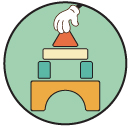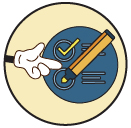This is part of the ADA Title 2 toolkit, a resource to help public entities start building digital accessibility strategies.
Public entities that use 3rd party tools are responsible for the content they post using that 3rd party tool. For example, if they use a 3rd party calendar widget to display events on the website, they are responsible for making sure that content is accessible.
What are vendor/3rd party tools?
Third party tools are anything you use or purchase to use in your digital content. These can be plugins on your website or software that you link to like Google Docs. This could include:
- Calendar widgets
- Google maps
- YouTube
- Content management systems
- Learning management system
- Form-building tools
- Email applications
- Other SaaS products
Considerations when establishing procurement procedures
Here are tasks to consider when establishing procedures for using or purchasing 3rd party tools:
- Communicate with 3rd party partners your accessibility needs.
- Inventory all 3rd party tools used.
- Test 3rd party tools accessibility with WAVE, keyboard, text zoom, and screen reader testing.
- Include 3rd party tools in organizational accessibility policies. This could mean:
- Potential Vendors are required to provide a VPAT.
- Accessibility requirements are included in contracts.
- Communicate with 3rd party partners your accessibility needs.
Learn ways to check your third party tools plus an email template to use with vendors: How to check 3rd party vendors for accessibility.
When vendors/3rd party tools aren’t accessible
Ideally, there is an accessible solution you can choose. The reality is that many 3rd party tools won’t be perfectly accessible, and sometimes there is no accessible option. But, your organization still has to decide whether to use that tool.
Here are some ways to handle key software that has issues:
Accept the risk
Your org might decide to accept the risk of using inaccessible software. If so, decide:
- Who is the person signing off on that risk?
- Are there accommodations or support that could be put in place to minimize the risk and help people with disabilities use the software?
Customize the software
If the software is customizable, your institution could add the necessary accessibility to it.
Work with the vendor
Communicate requirements with the vendor and determine their willingness to reach accessibility together. You can present this as a business opportunity to them as they work with more public entities that have accessibility requirements and partner to do the work.
It’s important to gauge the vendor’s willingness to do this work, or you could be stuck in a situation where they say they will but never do.
Learn more about public entities’ responsibilities when it comes to third-party tools.
Want a jump start?
Our accompanying webinar covers how to break up your accessibility efforts into more manageable pieces with real-life examples.
Start in the right direction quicker.
Our experts are here to help plan your ADA compliance strategy.
 How Pope Tech helps
How Pope Tech helps
Fixing existing issues and building an accessibility strategy that people actually adopt is difficult. It requires inventorying, training, continuous communication, planning, and tracking.
Pope Tech currently has a direct integration with Canvas. It has an Accessibility Guide, which helps instructors and designers find and fix issues, and dashboards to monitor results.

Identify your content
- Inventorying webpages
- Inventorying videos
- Inventorying PDFS
- Inventorying all Canvas course content

Prevent future issues
- Accessibility topic training for contributors
- Product training for organization
- Accessibility documentation to help people learn as they go
- Scheduled automated and manual testing
- Scheduled and automated reporting to anyone in your organization
- Easy-to-use dashboard to track progress and spot emerging issues
- User organization to make sure everyone has access to what they need

Test and fix existing issues
- Automated accessibility testing
- Guided manual testing flow
- Integrations with Jira, Asana, and email to send tasks directly to contributors
- API integrations to customize your flows
- Identifying issues with 3rd party tools
- Access to accessibility experts to answer any questions






